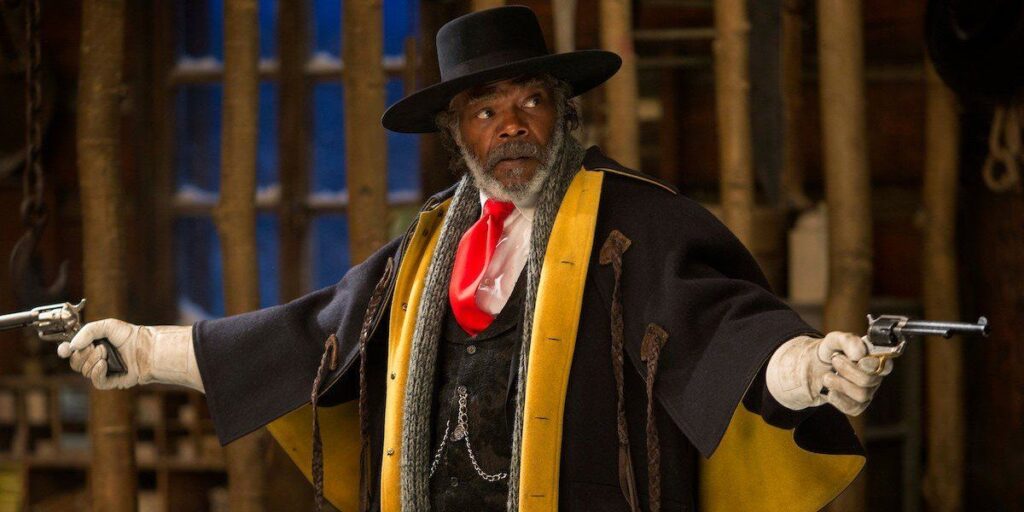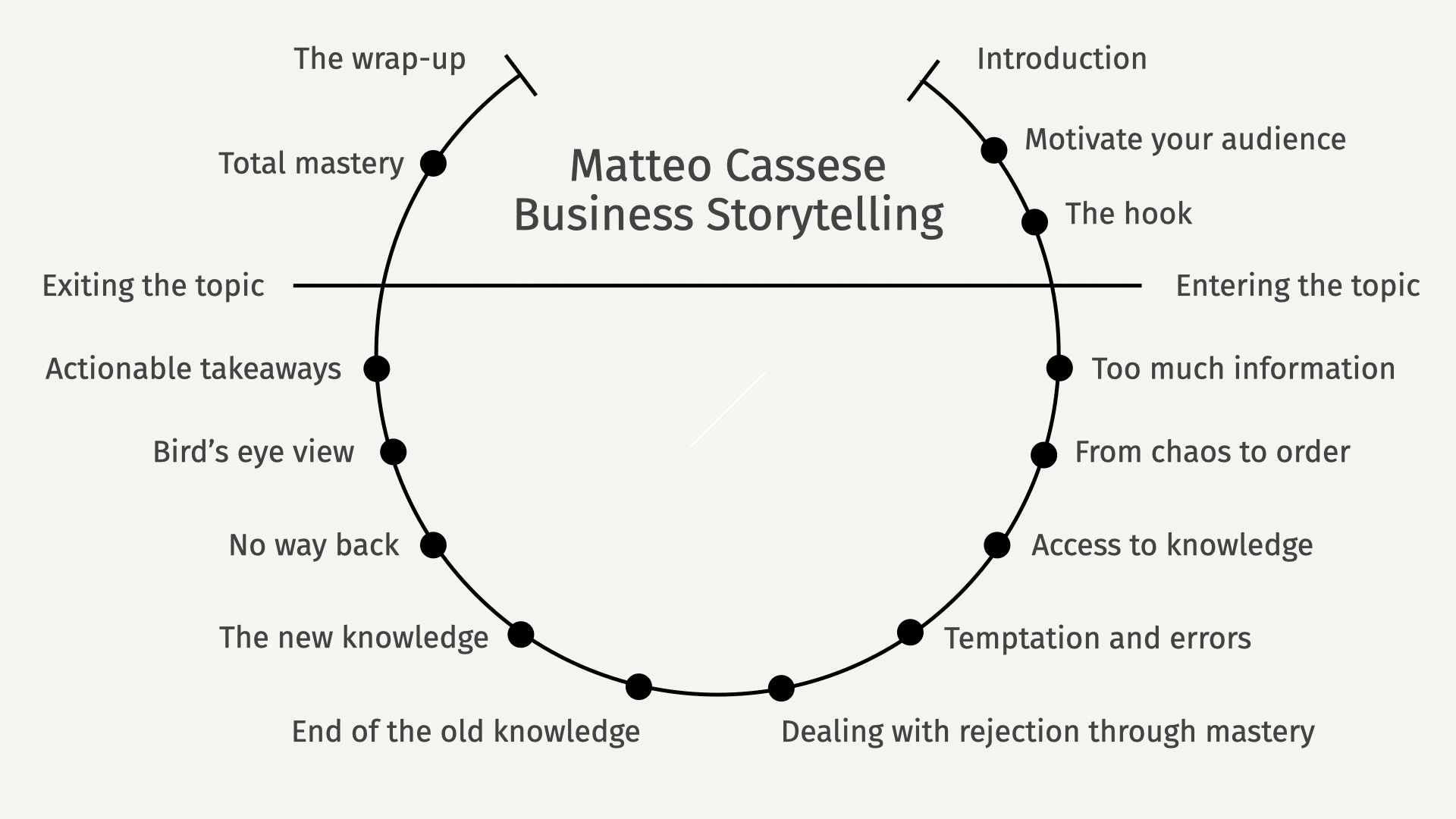Introduction: Why Story Structure Matters in Business
Storytelling, and in particular business storytelling, is the only way we can move our peers to action. It’s the only way we can elicit emotions and persuade our colleagues, bosses, clients and stakeholders.
But to move from the theory of business storytelling to the practice of persuasion, we need to understand and master a fundamental tool: story structure.
What is a story structure?
A story structure is a way of organizing information so that it becomes irresistible to the people listening.
If you think of a Quentin Tarantino movie, for instance, every film starts in the middle of the action. This is a story structure. Rather than telling you who the characters are, what they’re doing, or where they’re coming from, Tarantino chooses a technique that puts you in the middle of a saloon where everybody’s pointing a gun at everybody else’s head. This is a deliberate story structure choice.

When you tell a bedtime story to a child, the first thing you say is “Once upon a time, in a land far, far away, there were these characters.” You set up the scene for a fairy tale. That is a story structure.
When you tell a joke, you present characters in a situation, that situation becomes funny, and only at the end do you deliver the punchline. There isn’t any joke that starts with the punchline. The fact that the punchline comes at the end is a story structure.
The Hero’s Journey for Business Applications
You will find many story structures described by countless experts. Chances are they are all derivatives of the original story structure: the hero’s journey as presented by Joseph Campbell in his seminal book “The Hero With a Thousand Faces,” first published in 1949. Every business story, literally every story, derives from the structure explained in this book.
But as written, this book talks about meeting goddesses and having magical flights. It doesn’t seem like something for you and me in the boardroom, right? What I want to present is a way to use this profound 1949 theory in practice, in the boardroom and on stage.
The Classic Dramatic Structure
There is one traditional dramatic structure, summarized by the three-act structure. We find this structure in Greek theater and in the latest Avengers movie.
This structure can be further divided into the 17 steps belonging to three acts of the Hero’s Journey as codified by Joseph Campbell. Next to the original name of each chapter you will see how this informs business storytelling.

- The Call to Adventure – Introduction
- Refusal of the Call – Motivation
- Supernatural Aid – The Reveal
- Crossing the First Threshold – Entering the Topic
- In the Belly of the Whale – Too Much Information
- The Road of Trials – From Chaos to Order
- Meeting with the Goddess – Access to Knowledge
- Temptation – Temptations and Errors
- Atonement with the Father – The Mastery of Knowledge
- The Encounter with Death/Resurrection – End of the Old Knowledge
- The Ultimate Boon – The Birth of the New Knowledge
- Refusal of the Return – No Way Back
- Magic Flight – Birds Eye View
- Rescue from Without – Actionable Takeaways
- Crossing the Return Threshold – Ready to End
- Mastery of Two Worlds – Perfect Mastery of the Old and the New Knowledge
- Freedom to Live – The Epic Wrap-Up

Alternative Approaches to the Hero’s Journey
A simplified view of the Hero’s Journey can be found in the work of Christopher Vogler. This version is geared more towards movie and book writers.
- Ordinary World
- Call to Adventure
- Refusal of the Call
- Meeting the Mentor
- Crossing the Threshold
- Tests, Allies, Enemies
- Approach to the Inmost Cave
- Ordeal
- Reward (Seizing the Sword)
- The Road Back
- Resurrection
- Return with the Elixir
The Storytelling Mountain: Our Simplified Framework
At myth maker we have developed our own Storytelling Mountain, and during our courses we will help you climb it with ease.

- Tell your audience who you are.
- Tell your audience why you’re there.
- Tell your audience why they’re there.
- Transform your audience.
- Everyone reacts differently.
- Mark the most important concept.
- Provide a summary.
- Provide actionable to-dos.
If you wish to explore each of these steps in detail, check the bonus section below where I provide examples for each of these storytelling moments.
Understanding Story Arcs

The story arc helps us locate where in the structure of a narrative we find ourselves. The form of an arc perfectly describes the fact that we start on the ground, rise to great heights, and land back on the ground at the end of our adventure.
Story arcs usually respect the three-act structure and follow the 17 steps of the hero’s journey. However, the order in which these features appear can be rearranged to follow the specific needs of your narrative.
The 17 Building Blocks of Business Storytelling
In this bonus section I explain all 17 steps of the business storytelling journey, examining them through the lens of corporate narratives and illustrating each step with movie scenes for clarity.
The Call to Adventure – Introduction
The protagonist of every story doesn’t wish to leave the comfort of her home or her life. She’s contempt in her skin, has friends, is well connected. Yet she receives a call.
Our business narratives need to reach our audiences. Yet these audiences don’t yet know about the journey they will soon make. They need a hint, an introduction.
Messages rarely reach their recipient without a little bit of struggle, as this famous scene from the original Harry Potter movie demonstrates very well.
Refusal of the Call – Motivation
As the message about a new adventure reaches our protagonist, she is adamant that nothing needs to change in her life: all is perfect as it is.
Our business narrative will also be judged as irrelevant, non-necessary, immaterial by our audience. This is why all our efforts will initially be focused on motivating our audience to even pay attention to the new narrative.
In movies even the most effective and motivated heroins and heroes refuse the call to adventure. As is demonstrated by Neo in this scene from the original Matrix movie.
Supernatural Aid – The Reveal
Those who prepare for an important journey need assistance. The heroin in our story is not ready to leave her world, but she receives an unexpected visit that forces her decision making.
Our business narrative could remain stale if we are not able to make it relevant to our audience: how will the world look like when our business story has come to fruition? Our boardroom story need a supernatural aid.
Sometimes this aid does not look like a helper, but rather like a hindrance. Case in point is the first encounter between Master Yoda and a rather restless young Luke Skywalker.
Crossing the First Threshold – Entering the Topic
The time has come for our protagonist to accept that the adventure has begun, that she walks in a new adventurous world with old shoes.
Our business narrative needs to start somewhere, we can’t linger on the introduction from much longer. We need to show our audience what would happen if our narrative went mainstream. We need to reveal what the journey is about. Nothing is going to be the same.
Old shoes, new shoes, old world, new world: none of these metaphors can find a better explanation that the one provided in The Wizard of Oz: “Toto, we’re not in Kansas anymore…”
In the Belly of the Whale – Too Much Information
New worlds come embedded with the pain of changing. Our heroin at first is crushed by the sheer amount of new lessons that are coming from left to right. The first reaction is sheer confusion. She doesn’t know which way is up.
Our business narrative faces similar perils. New ideas, concepts and principles need to encounter resistance before they are adopted. We wish to change our audience, and the same audience is confused about this change. Once we accept it we can start honing our message and cut through to our target group.
George Lucas hired Hero’s Journey author Joseph Campbell to help craft the Star Wars universe. This is why the confusion here is represented by the “mechanical belly” of a trash compactor, a direct reference of the belly of the whale.
The Road of Trials – From Chaos to Order
Our protagonist may be overwhelmed at first, but the confusion helps her focus on the goal. The adventure challenges her progressively, and she faces the trials one by one.
Our business narrative is starting to make sense. Each audience group will have objections to our proposed change. And for each change we will have persuasive arguments: this is how we will bring our audience from the chaos of too much information to the order that is needed to comprehend it and accept it.
Most movies feature trials and tests. Certainly one of the most memorable is that of Ripley in Alien.
Meeting with the Goddess – Access to Knowledge
Engaging with the trials gives our protagonist new powers. She gets closer to being able to understand the supernatural. This is why in the hero’s journey she is now ready to meet the powerful and all knowing Goddess.
Our business narrative needs to deliver a big revelation to our audience. They need to see the rational and the emotional elements of the transformative journey we are presenting to them. Once they can see the precise frame of our narrative, they can access its true nature in detail.
Our cinematic example is the encounter of the scruffy and likeable WALL-E with the almighty EVE and the start of their friendship.
Temptation – Temptations and Errors
The protagonist of our story is a human after all. And she will fall prey to temptation: specifically she will feel drawn to less savory aspects of the new world she’s exploring.
In the same vein once your colleagues in the boardroom know a little about your message, they will think they know it all. They will start to look for shortcuts. They will make assumptions that lead to mistakes.
There is no better example of temptation that the call of the “dark side of the force” in the Star Wars universe.
Atonement with the Father – The Mastery of Knowledge
Storytelling speaks to us through tropes and archetypes. This passage has nothing to do with your or anybody’s father. It’s a about gaining permission. Our protagonist has learned the theory the hard way through her trials, now she has to apply what she learned. But she can execute only if and when she finally gives herself permission to practice what she knows.
In the boardroom this means showing our audience the depth and breadth of the change we are inviting them to make. And we can only do that if we give ourselves permissions to master the topic.
For the cinematic example we are back in the Star Wars universe, where literally Luke needs to reconcile with his own father in a rather dramatic moment.
The Encounter with Death/Resurrection – End of the Old Knowledge
Like a phoenix our protagonist needs to die and be re-born from her ashes to finally give order to the new world she’s exploring.
In our business story we have spent a lot of time motivating, inviting, providing clarity. Now these moments need to compound and lead our audience to a moment of clarity. The old way of thinking is dead.
In cinema at this point the screen goes dark and we don’t know if our protagonist is alive or dead. It’s a split second visually, but emotionally it last much longer. Our example is rather gruesome one, coming from the seminal movie Fight Club. Viewer discretion is advised.
The Ultimate Boon – The Birth of the New Knowledge
Our protagonist can now show the world her new form, her new shape, her new power. She’s changed and she is free to use the her abilities.
In the business story this step is deeply linked with the End of the Old Knowledge. As this represent the victory of the message over the resistance of the audience.
The best example in cinematic terms is the ability that Neo gains in the original Matrix movie to sync his movements to the speed of bullets: “bullet time.”
Refusal of the Return – No Way Back
Our heroin is now in control in this new world. Why would she want to go back to the ordinary world of her previous (boring) life?
The situation in the boardroom is similar. In this case the speaker and storyteller is enjoying the talk too much and might linger too long on stage. The point has been made; it’s time to go back.
Sometimes in the movie the protagonists don’t believe that they road is clear for them to go home. Like in this short clip again from Star Wars.
Magic Flight – Birds Eye View
To understand that she has to make the journey home, the protagonist is shown the world from a new perspective: she’s taken on a flight.
In our business story this is the moment to take our audience flying above to topic, show them where the journey took us, how much they traveled. This is done by summarizing the key points of the business story to help our audience make sense and memorize them.
Flying is part of the exhilaration and clarity of the end of many movies. Here’s a montage of some of the most meaningful flights in recent movies.
Rescue from Without – Actionable Takeaways
The protagonist of our story needs a final nudge as she would want to linger in the adventure world. This nudge usually comes from a character we’ve known throughout the story but that hasn’t had a leading role until now. But they give an important gift of knowledge to the heroin and help her complete the journey.
In the boardroom and on stage this is a fundamental step: at this moment the story needs to become practical. Once your audience has made sense of the new concepts they should immediately be put into practice. I call this “actionable takeaways.” These are the next steps after a meeting, but also the instructions on how to make the change last in the day to day life of your audience.
We are back to the Star Wars universe to see the hero Han Solo being rescued from being frozen in carbonite by Leia. Both remain captive for the moment, but it’s the initiative of Leia (who in the story is the one being saved) that represents the first step of Han’s liberation.
Crossing the Return Threshold – Ready to End
It’s time for our protagonist to step into the old, ordinary world where she comes from.
In the same vein it’s our time to end the presentation, step off stage, conclude the narrative and let our audience go back to their day, to their work but made stronger by the transformation we have brought through our narrative.
The best example is the return to the Shire of the fellowship of the ring. The young hobbits that left are very different from the ones that return.
Mastery of Two Worlds – Perfect Mastery of the Old and the New Knowledge
Finally our protagonist has find the strength to reconcile her two lives: the one she lives in the ordinary world, and the one that she experiences in the adventure world. She acknowledges her own power and her transformation is finally being recognized by her peers.
Our business narrative is over, we are now dealing with its consequences. We now debate, consult and exchange ideas with our audience. They now master both the old knowledge and the new knowledge brought by the business narrative and can best comprehend all the nuances.
A good example of this step is how all the characters in Lord of the Rings react to the the coronation of Aragorn.
Freedom to Live – The Epic Wrap-Up
Stories feed on conflict. Once the quest is over the attention of the audience diminishes. The only step missing for our protagonist is for us to see her free to continue her new life.
In the same way we have the duty to wrap things up, gather feedback and let our audience on their way an onto the rest of their (work) life.
A great way to conclude our journey is to see how Disney conceived both the climax, resurrection, rescue from without and wrap up of the movie Frozen.
What’s next?
A great way to continue from here is to read my extensive business storytelling guide.
I always welcome inquiries for storytelling keynotes or business storytelling coaching.

